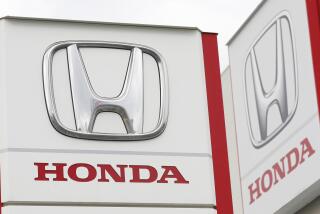There’s No Glossing Over Rust Problem
- Share via
Question: I bought a new Honda Accord hatchback in 1985. About three years later, the car developed a rust problem on the roof. Honda agreed to pay for the repainting of the roof because of their 3-year rust guarantee. Within eight months, the rust had returned, but it was now at many different places on the car, including the door post frames, rear deck and passenger door. Honda agreed to pay for 50% of the repairs. How can they live up to their guarantee when it appears no repair is possible? What can be done?--F.H.
Answer: Very possibly nothing can be done to fully restore your car’s finish. It may be so damaged that only a complete paint stripping and repainting will help. That could nearly exceed the value of the car and then might not prevent a recurrence of the corrosion.
Honda used a one-stage paint process for its white color in 1985, which means the car does not have a clear coat that is typically used with other colors in a two-stage paint system.
The clear coat apparently offers significant protection against certain types of premature failure of the paint, assuming the paint was properly applied at the factory and the metal properly prepared for painting at the factory.
If the metal was not properly prepared--if there was corrosion on the metal before it was painted in Japan, for example--then the rust developing now would likely be large spots measuring an eighth to a quarter of an inch in diameter, according to Ken Zion of Long Beach, an instructor in auto body repair at El Camino College and a consultant in auto body litigation.
More likely, the paint has been attacked by some sort of atmospheric industrial fallout. Such fallout often contains particles of iron that embed themselves in the paint and then begin to rust. The rust occurs on the surface of the paint, but after a while it travels right through the paint and can begin rusting the sheet metal of the car.
Ruined Paint Job
At that point, you have a ruined paint job. Hondas aren’t the only cars with such a problem, but the company recognizes that it does have such a problem, no matter what any dealer tries to say. The company has developed a wash, which it describes as an acid wash, that can remove the embedded particles of rust before they burn through the paint. Then, you must keep the paint clean and waxed to protect it from a recurrence.
The problem is particularly severe in Los Angeles, where the air is foul and the sun is strong enough to literally bake fallout into the paint. If the car is parked near the beach, that compounds the entire problem because the salt air accelerates the corrosion.
If the sheet metal of your Accord has begun to corrode, a paint job is going to be quite involved. The existing paint must be stripped to the bare metal before the car can be primed and painted. Based on conservative estimates, the stripping would cost about $1,500 and the repainting about $2,500, including a reasonable amount of disassembly of trim and body parts. You probably do not want to spend $4,000 on painting a 4-year-old car, or even $2,000 if you can get Honda to foot half the bill.
One alternative is to accept the fact that your Accord is a lemon of sorts and make the best of it. For example, you could have the car painted on the cheap for under $100. It will not last long, but you could have it repainted every year for the next few years. It would be a lot cheaper and less risky than the $4,000 paint job that may not work either.
But if you can’t stomach an $89.95 paint special, you could sue Honda in small claims court for up to $2,000. Then you could take the $2,000 and spend it however you wished. If you go to court, you might want to consult an expert witness in auto body repair, such as Zion’s Automotive Collision Consultants.






